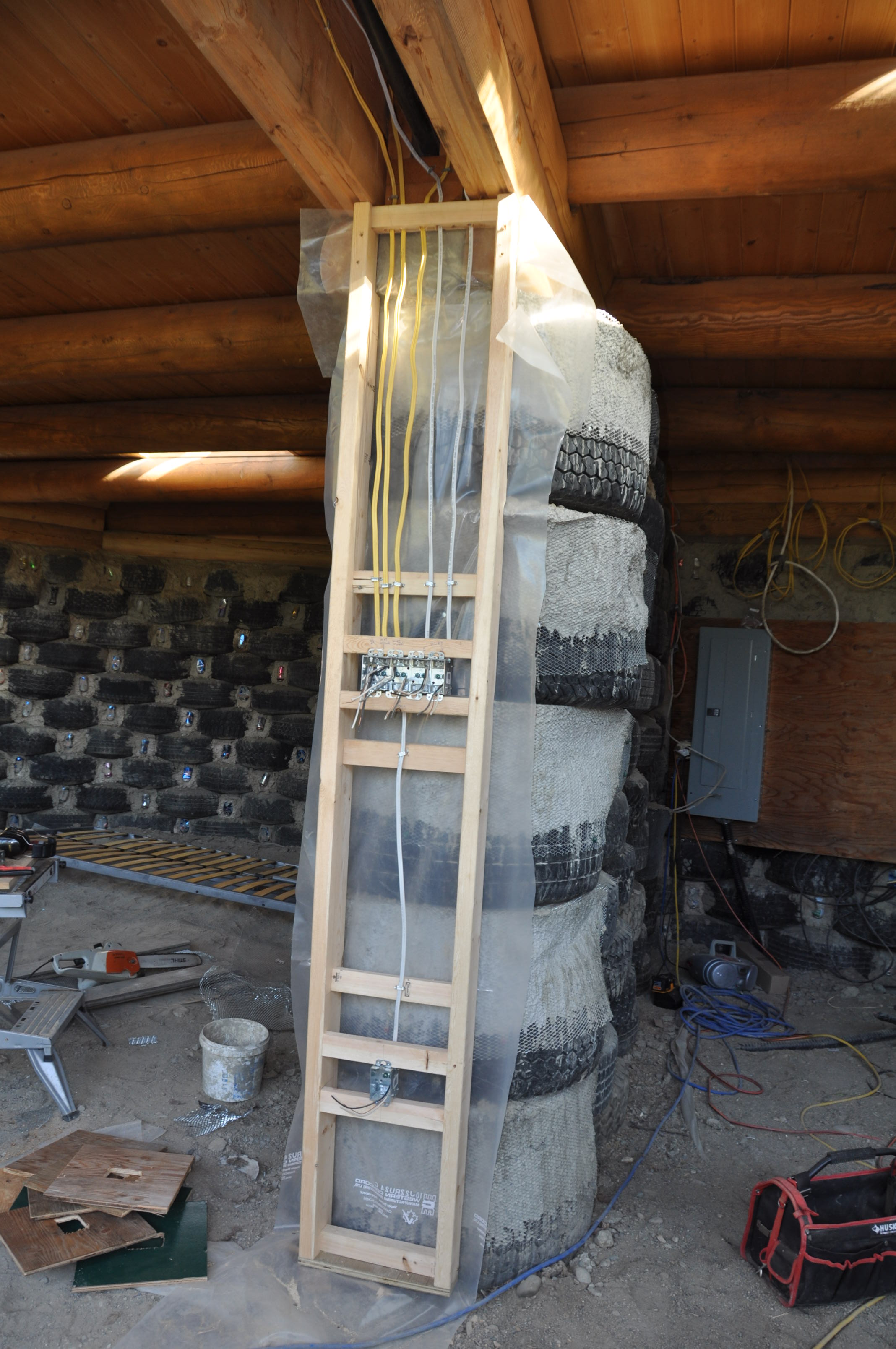
It has been a few days since we finished our rough-in wiring, but I thought I would post about it before I forget the details.
As mentioned previously we spent some time after getting our electrical permit figuring out what type of wire would be required for the tire walls; the electrical inspector initially wanted us to use metallic or non-metallic conduit to protect against corrosion and moisture. Based on our research of other buildings of cob construction in British Columbia we were able to show the building inspector that standard wiring and boxes have been used in buildings with similar construction techniques.
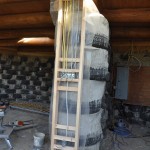 Last week we finally started the rough-in wiring of the tire walls. I started working on the ends of the interior tire walls; we have wire running in channels at the tops of these walls and there will be switch outlets on the ends of all of these walls. We decided to frame a wiring chase on the end of every wall rather than cob over this wiring. There were two reasons for this choice; I was worried that there would not be a lot of cob covering the wire runs on the ends of the walls, and we intend to finish these chases so that they look like posts at the ends of the interior walls … we hope that it will be aesthetically pleasing. Making these boxes was slow work as the 2×6 forming the box had to be custom fit to the tire stack. Eventually we will cob over the custom edges of the 2×6 when we finish mudding the walls.
Last week we finally started the rough-in wiring of the tire walls. I started working on the ends of the interior tire walls; we have wire running in channels at the tops of these walls and there will be switch outlets on the ends of all of these walls. We decided to frame a wiring chase on the end of every wall rather than cob over this wiring. There were two reasons for this choice; I was worried that there would not be a lot of cob covering the wire runs on the ends of the walls, and we intend to finish these chases so that they look like posts at the ends of the interior walls … we hope that it will be aesthetically pleasing. Making these boxes was slow work as the 2×6 forming the box had to be custom fit to the tire stack. Eventually we will cob over the custom edges of the 2×6 when we finish mudding the walls.
On each of the end walls I put a 3 or 4 gang electrical box approximately 4′ above finished floor height. These boxes will hold the light switches for the main room lights. The intention is for all of the lighting circuits to be on DC power. I ran some of these branch circuits using #10 AWG wire due to the length of the runs and number of lights on the circuit; I did not want any issues with voltage drop due to insufficient wire sizes. I also placed a single gang box approximately 1′ above finished floor level in these chases. This allows me to have a DC plugin in every room, something I was not sure how I was going to accomplish otherwise. I did not include these DC plugins when ensuring that there was no point along the wall of the room further than 12′ from an electrical outlet; I ensured that you are always within 12′ of an AC plugin.
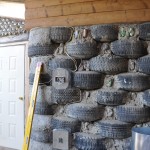 Once these end wall chases were finished we moved on to the wiring beside the east and west exterior doorways. Here again electrical wiring for room lights travelled in a channel at the top of the tire wall. This wiring was brought down to approximately 4′ above finished grade into a switch receptacle gang box by running it in the recessed grooves between the tires. The wires were attached to the tires using 3/4″ screws and CSA approved wire clips. Here again, a single gang plugin was placed underneath the switch box.
Once these end wall chases were finished we moved on to the wiring beside the east and west exterior doorways. Here again electrical wiring for room lights travelled in a channel at the top of the tire wall. This wiring was brought down to approximately 4′ above finished grade into a switch receptacle gang box by running it in the recessed grooves between the tires. The wires were attached to the tires using 3/4″ screws and CSA approved wire clips. Here again, a single gang plugin was placed underneath the switch box.
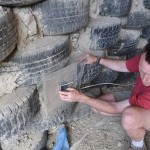 Finally, all of the branch circuits were run for the plug receptacles on the tire walls. All of these gang boxes were mounted on plywood screwed over the cavity between two tires in the wall. A box was cut out of the plywood using a jigsaw and the gang box was mounted and screwed to the plywood. Before mounting the gang box 6 mil poly and stucco lathe was stapled over the exposed face of the plywood. The lathe extends beyond the edges of the plywood. As described above the electrical wire was stapled in the cavities formed between the tires.
Finally, all of the branch circuits were run for the plug receptacles on the tire walls. All of these gang boxes were mounted on plywood screwed over the cavity between two tires in the wall. A box was cut out of the plywood using a jigsaw and the gang box was mounted and screwed to the plywood. Before mounting the gang box 6 mil poly and stucco lathe was stapled over the exposed face of the plywood. The lathe extends beyond the edges of the plywood. As described above the electrical wire was stapled in the cavities formed between the tires.
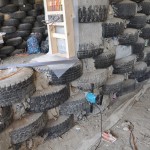 We passed the wire between rooms by drilling through the cob packed between the tires. This worked well and reduced the wire runs as we did not have to go right out to the end of each wall. We made sure the wire was stapled within 6″ of entering a gang box and at least every 5′ feet along its length. At least 6″ of conductor was run into the gang boxes.
We passed the wire between rooms by drilling through the cob packed between the tires. This worked well and reduced the wire runs as we did not have to go right out to the end of each wall. We made sure the wire was stapled within 6″ of entering a gang box and at least every 5′ feet along its length. At least 6″ of conductor was run into the gang boxes.
All of this work took two of us three days.